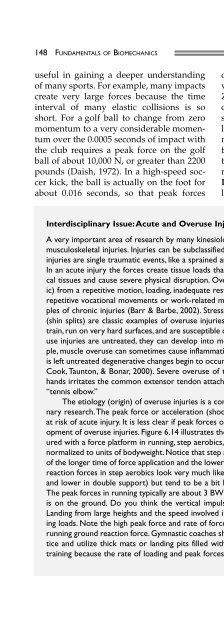Fundamentals of Biomechanics
Fundamentals of Biomechanics
Fundamentals of Biomechanics
Create successful ePaper yourself
Turn your PDF publications into a flip-book with our unique Google optimized e-Paper software.
148 FUNDAMENTALS OF BIOMECHANICS<br />
useful in gaining a deeper understanding<br />
<strong>of</strong> many sports. For example, many impacts<br />
create very large forces because the time<br />
interval <strong>of</strong> many elastic collisions is so<br />
short. For a golf ball to change from zero<br />
momentum to a very considerable momentum<br />
over the 0.0005 seconds <strong>of</strong> impact with<br />
the club requires a peak force on the golf<br />
ball <strong>of</strong> about 10,000 N, or greater than 2200<br />
pounds (Daish, 1972). In a high-speed soccer<br />
kick, the ball is actually on the foot for<br />
about 0.016 seconds, so that peak forces<br />
Interdisciplinary Issue:Acute and Overuse Injuries<br />
on the foot are above 230 pounds (Tol, Slim,<br />
van Soest, & van Dijk, 2002; Tsaousidis &<br />
Zatsiorsky, 1996). Fortunately, for many<br />
catching activities in sport an athlete can<br />
spread out the force applied to the ball over<br />
longer periods <strong>of</strong> time. The Impulse–Momentum<br />
Relationship is the mechanical law<br />
that underlies the Force–Time Principle introduced<br />
earlier in chapters 2 and 4. Let's<br />
revisit the application <strong>of</strong> the Force–Time<br />
Principle with our better understanding <strong>of</strong><br />
linear kinetics.<br />
A very important area <strong>of</strong> research by many kinesiology and sports medicine scholars is related to<br />
musculoskeletal injuries. Injuries can be subclassified into acute injuries or overuse injuries.Acute<br />
injuries are single traumatic events, like a sprained ankle or breaking a bone in a fall from a horse.<br />
In an acute injury the forces create tissue loads that exceed the ultimate strength <strong>of</strong> the biological<br />
tissues and cause severe physical disruption. Overuse injuries develop over time (thus, chronic)<br />
from a repetitive motion, loading, inadequate rest, or a combination <strong>of</strong> the three. Injuries from<br />
repetitive vocational movements or work-related musculoskeletal disorders (WMSDs) are examples<br />
<strong>of</strong> chronic injuries (Barr & Barbe, 2002). Stress fractures and anterior tibial stress syndrome<br />
(shin splits) are classic examples <strong>of</strong> overuse injuries associated with running. Runners who overtrain,<br />
run on very hard surfaces, and are susceptible can gradually develop these conditions. If overuse<br />
injuries are untreated, they can develop into more serious disorders and injuries. For example,<br />
muscle overuse can sometimes cause inflammation <strong>of</strong> tendons (tendinitis), but if the condition<br />
is left untreated degenerative changes begin to occur in the tissue that are called tendinoses (Khan,<br />
Cook, Taunton, & Bonar, 2000). Severe overuse <strong>of</strong> the wrist extensors during one-handed backhands<br />
irritates the common extensor tendon attaching at the lateral epicondyle, <strong>of</strong>ten resulting in<br />
“tennis elbow.”<br />
The etiology (origin) <strong>of</strong> overuse injuries is a complex phenomenon that requires interdisciplinary<br />
research.The peak force or acceleration (shock) <strong>of</strong> movements is <strong>of</strong>ten studied in activities<br />
at risk <strong>of</strong> acute injury. It is less clear if peak forces or total impulse are more related to the development<br />
<strong>of</strong> overuse injuries. Figure 6.14 illustrates the typical vertical ground reaction forces measured<br />
with a force platform in running, step aerobics, and walking. Note that the vertical forces are<br />
normalized to units <strong>of</strong> bodyweight. Notice that step aerobics has peak forces near 1.8 BW because<br />
<strong>of</strong> the longer time <strong>of</strong> force application and the lower intensity <strong>of</strong> movement.Typical vertical ground<br />
reaction forces in step aerobics look very much like the forces in walking (peak forces <strong>of</strong> 1.2 BW<br />
and lower in double support) but tend to be a bit larger because <strong>of</strong> the greater vertical motion.<br />
The peak forces in running typically are about 3 BW because <strong>of</strong> the short amount <strong>of</strong> time the foot<br />
is on the ground. Do you think the vertical impulses <strong>of</strong> running and step aerobics are similar?<br />
Landing from large heights and the speed involved in gymnastics are very close to injury-producing<br />
loads. Note the high peak force and rate <strong>of</strong> force development (slope <strong>of</strong> the F–t curve) in the<br />
running ground reaction force. Gymnastic coaches should limit the number <strong>of</strong> landings during practice<br />
and utilize thick mats or landing pits filled with foam rubber to reduce the risk <strong>of</strong> injury in<br />
training because the rate <strong>of</strong> loading and peak forces are much higher (8 BW) than running.






